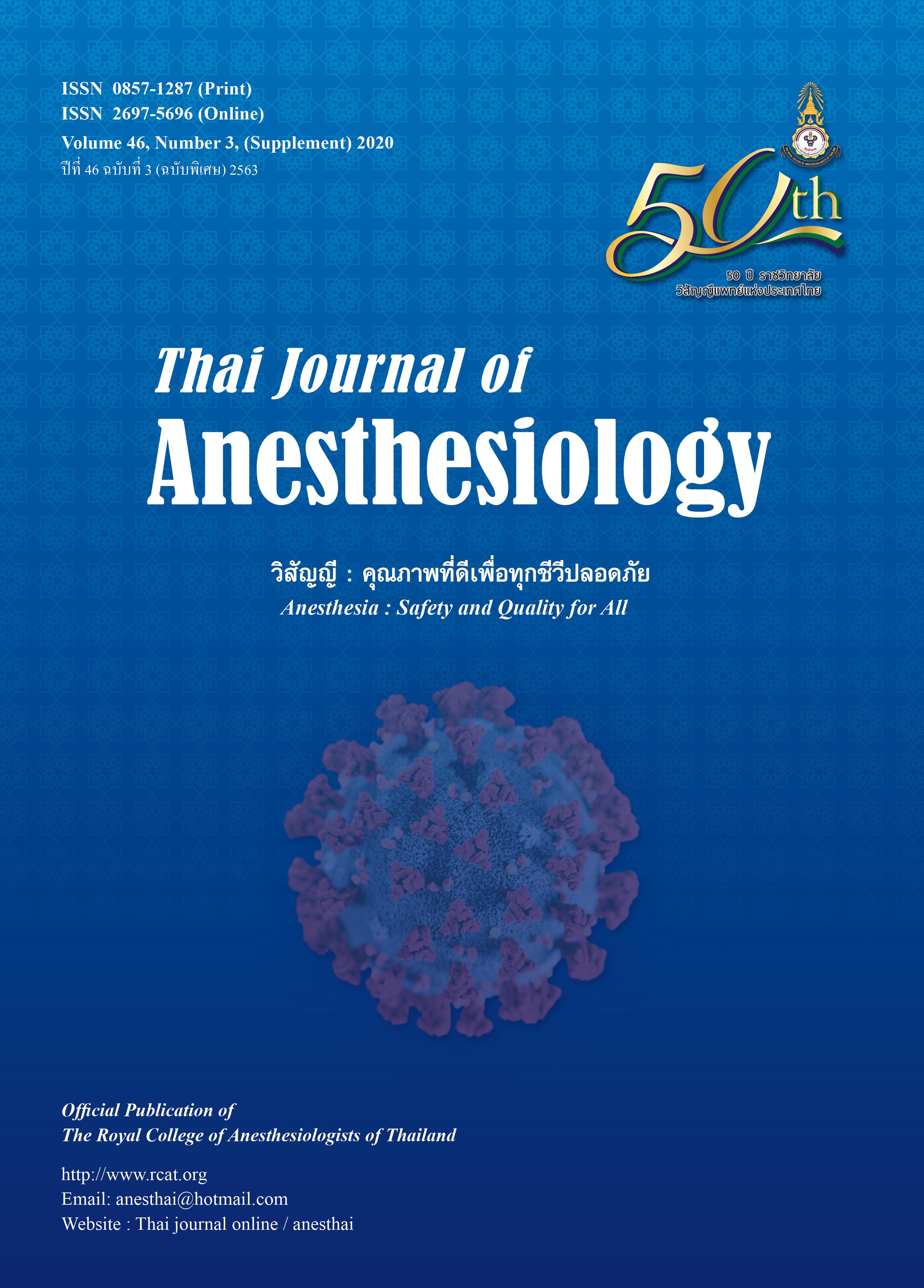The Problems and Tips for Use of the GlideScope® Video Laryngoscope for Endotracheal Intubation in the COVID-19 Pandemic
Main Article Content
Abstract
During the current outbreak of novel coronavirus
disease 2019 (COVID-19), anesthesiologists and
healthcare workers who are involved in airway
management are particularly at risk of infection due to
intubation. Because intubation is aerosol generating
procedure which increase the risk of viral transmission,
anesthesiologists and intubators should be careful when
performing endotracheal intubation. Video laryngoscope
is an intubation device that has camera and LED
illumination fixed to the distal part of the laryngoscope
blade. GlideScope® video laryngoscope has been widely
used to facilitate endotracheal intubation. It occasionally
is difficult to advance the endotracheal tube into the
trachea even with a good view of glottis. Patients with
COVID-19 could have risk of rapid arterial oxygen
desaturation due to limitation in preoxygenation and
manual positive pressure ventilation before intubation.
Therefore, time to intubation is very important to reduce
that risk. This article demonstrates problems and some
tips for GlideScope® use in current situation and the next
new normal practice.
Article Details
References
patients infected with 2019 novel coronavirus in
Wuhan, China. Lancet 2020; 395: 497–506.
2. Ibinson JW, Ezaru CS, Cormican DS, Mangione MP.
GlideScope use improves intubation success rates:
an observational study using propensity score
matching. BMC Anesthesiology 2014; 14(1):101.
3. Malik AM, Maharaj CH, Harte BH, Laffe JG.
Comparison of Macintosh, Trueview EVO2®,
Glidescope®, and Airwayscope® laryngoscope use
in patients with cervical spine immobilization. Br J
Anesth 2008;101:723-30.
4. Kass DA, Duggal P, Cingolani O. Obesity could
shift severe COVID-19 disease to younger ages.
Lancet 2020;395:1544-45.
5. Sheta SA, Abdelhalim AA, ElZoughari IA. Parker
Flex-It stylet is as effective as GlideRite Rigid stylet
for orotracheal intubation by Glidescope. Saudi
Med J 2015;36:1446-52.
6. Lee YC, Lee J, Son JD, Lee JY, Kim HC. Stylet
angulation of 70 degrees reduces the time to
intubation with the GlideScope®: A prospective
randomised trial. J Int Med Res 2018;46:1428-38.
7. Bacon ER, Phelan MP, Doyle DJ. Tips and
troubleshooting for use of the GlideScope video
laryngoscope for emergency endotracheal
intubation. Am J Emerg Med 2015;33:1273-7.
8. Walls RM, Samuels-Kalow M, Perkins A. A new
maneuver for endotracheal tube insertion during
difficult Glidescope intubation. J Emerg Med.
2010;39:86-8.
9. Magboul MMA, Joel S. The video laryngoscopes,
blind spots and retromolar trigonum injury by the
GlideRite® rigid stylet. Anesth Essays Res 2010;4:
112-14.
10. Hsu WT, Hsu SC, Lee YL, Huang JS, Chen CL.
Penetrating injury of the soft palate during
GlideScope intubation. Anesth Analg 2007;104:
1609-10.
11. Thong SY, Goh SY. Reported complications
associated with the use of GlideScope® video
laryngoscope-How can they be prevented? OA
Anaesthetics 2013;1:1.
12. Cooper RM. The GlideScope videolaryngoscope.
Anaesthesia 2005;60:1042.
13. Corda DM, Riutort KT, Leone AJ, Qureshi MK,
Heckman MG, Brull SJ. Effect of jaw thrust and
cricoid pressure maneuvers on glottic visualization
during GlideScope videolaryngoscopy. J Anesth
2012; 26: 362-8.


